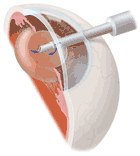What is Phacoemulcification, or phaco?
 Phacoemulsification is a modern cataract surgery first developed by Charles Kelman in 1967. The discovery of phacoemulsification came as a boon for the medical fraternity, where a cataractous lens could be emulsified through a small incision of 2-3 mm, giving perfect visual outcomes.
Phacoemulsification is a modern cataract surgery first developed by Charles Kelman in 1967. The discovery of phacoemulsification came as a boon for the medical fraternity, where a cataractous lens could be emulsified through a small incision of 2-3 mm, giving perfect visual outcomes.
Phacoemulsification is a modern cataract surgery method in which the eye's internal lens is emulsified with an ultrasonic handpiece and aspirated from the eye. Aspirated fluids are replaced with irrigation of balanced salt solution to maintain the anterior chamber.
A tiny probe is inserted through a very small incision on the side of the cornea (the clear, dome-shaped surface that covers the front of the eye). This instrument has a needle-like tip, which vibrates at an extremely high rate of speed caused by high frequency sound waves.
The ultrasonic vibration breaks the cataract into fine pieces, which are suctioned out of the eye through the needle. After all the cataract material is removed, the back half of the lens or capsule is left behind and the artificial lens is placed inside. Since this surgery is done with a very small incision, the wound closes on its' own and no stitches are required. This method is also called "no stitch" cataract surgery.
From less-traumatic surgery to earlier return of vision, new cold phaco cataract removal technology is delivering ever-increasing benefits to patients. Cold phaco systems offer new capabilities that allow surgeons to move up to the next step in cataract surgery-bi-manual micro-incision phacoemulcification. Visual outcomes are improved with this technology. Cold Phaco gives the surgeon the ability to control ultrasonics and aspiration simultaneously and independently.
With new technologies available cataract surgeons will be performing procedures with incisions as small as 1.0mm. With traditional phaco, wound burns are often a real possibility. The new cold phaco technology reduces risk to the patent and may enable better recovery.
 Advances have been made in cold phaco, particularly in energy efficiency, follow-ability and temperature regulation. It improves the delivery of ultrasonic energy to the anterior segment, which in turn, decreases the amount and duration of power delivered to the eye. The worst action one can take during phaco is delivering too much ultrasound energy. You don't even have to touch the cornea to create problems.
Advances have been made in cold phaco, particularly in energy efficiency, follow-ability and temperature regulation. It improves the delivery of ultrasonic energy to the anterior segment, which in turn, decreases the amount and duration of power delivered to the eye. The worst action one can take during phaco is delivering too much ultrasound energy. You don't even have to touch the cornea to create problems.
If you get close enough to the cornea with ultrasound emanating from the tip it can destroy endothelial cells. Jackhammer effect is useful for breaking the nucleus into small fragments. Cavitation, usually divided into transient and sustained, is the energy that emulsifies lens fragments. Initially, continuous ultrasound power delivers transient cavitation, which breaks the nuclear bonds to create emulsate. Sustained cavitation occurs after transient cavitation, when the energy becomes less focused and less powerful, and emulsifies the nucleus less effectively.
Continuous power is useful for until the nucleus breaks into fragments, you can emulsify them by switching from continuous to pulse modality. Some devices have such short on-off cycles that it maximises transient cavitation and becomes an effective emulsifying force, especially when the nucleus is in fragments. Ultimately delivering less ultrasonic energy to the eye with improved clinical outcome.
If you're using continuous ultrasound where no fluid is flowing back to the phaco needle, you can go from a normal temperature to wound burn in a couple of seconds. (Older phaco technology) With this new technology the temperature never goes above 32º C, even after 3 minutes of continuous running. We can attribute this excellent temperature control to the technology's duty cycle, or the relationship between off-time and on-time.
To explain this with a 'car' analogy. In a car, the accelerator controls the engine speed or RPMs. As you depress the accelerator, the engine revs, making the car move faster. Traditional phaco works on the same principle, allowing you to adjust phaco power linearly.
This technology also lets you move among the four basic phaco modes of continuous, pulse, power pulse and burst, but instead of setting two levels (occluded and un-occluded), you can set four double levels. To continue the car analogy, the duty cycle is like the car's gears. The more "on" you have relative to "off," the more efficient the gears. When working on a very dense cataract, it can stay at 20%, which pops up to 33% when the phaco tip occludes, and then the next level down can use 33% popping up to 43%. With Variable technology the foot pedal controls phaco power and duty cycles simultaneously, so can adapt technique for different stages of cataract removal.
One advantage of setting a long duty cycle or long off interval with Variable is improved follow-ability. Fragments stay near the tip and are emulsified with minimal energy. Less energy means less repulsive force and, consequently, less micro-chatter decreasing how much energy we use.
Operating a Phaco Machine
 A typical phaco machine consists of a handpiece, foot pedal, irrigation, and aspiration system. The handpiece consists of piezoelectric crystals. These crystals' two and fro motion produces the mechanical energy for emulsifying the nucleus. The stroke length of the handpiece depends on the power of the machine. The to and fro motion results in compression, producing gas bubbles that help disassemble the nucleus. This process is known as cavitation. The vibrations of the tip can be longitudinal or torsional, which aid in the mechanical disassembly of the nucleus. The operator's command over the foot pedal is critical in determining a perfect visual outcome.
A typical phaco machine consists of a handpiece, foot pedal, irrigation, and aspiration system. The handpiece consists of piezoelectric crystals. These crystals' two and fro motion produces the mechanical energy for emulsifying the nucleus. The stroke length of the handpiece depends on the power of the machine. The to and fro motion results in compression, producing gas bubbles that help disassemble the nucleus. This process is known as cavitation. The vibrations of the tip can be longitudinal or torsional, which aid in the mechanical disassembly of the nucleus. The operator's command over the foot pedal is critical in determining a perfect visual outcome.
All modern phaco machines have three positions in the foot pedal. Position 1 is for irrigation; 2 for irrigation and aspiration; and 3 for aspiration and ultrasound power. Power delivery can be fixed or variable. In fixed mode, the power delivery is fixed from 0 to 100%, while in variable mode, the depth of depression of the foot pedal determines the amount of energy delivered.
Phaco Power Delivery: The phaco energy delivery in the eye can have favourable and disastrous outcomes. Cavitation and chatter can result in damage. The heat generation during phaco power can result in thermal injury to the endothelium. Hence, it is imperative to use phaco power judiciously and safely. Intermittent phaco power delivery can be used instead of continuous mode to safeguard the endothelium. The size and angle of the tip can also be changed to improve cutting efficiency. Torsional and elliptical movement of phaco tip also helps in reducing energy generation.
Phaco Tip: Various tips are available with the bevel of 0, 15, 30, 45, and 60 degrees. A steeper bevel creates more holding force and higher cutting efficiency. The disadvantage is difficulty in achieving in a full vacuum. Phaco tip-end configuration can be bent, round, ellipsoid, or flared.
Modes of Phaco Delivery
- Pulse Modes: In this mode number of pulses per second are delivered with the foot pedal in position 3. There is also an off period during which no phaco power is delivered. The power of each pulse rises as the foot pedal is depressed further down to position 3. In position 3, maximum phaco power is delivered with each pulse.
- Burst-mode: Burst mode allows energy delivery of pre-set power (0-100%) separated by intervals of decreasing energy in position 3 of the foot pedal. When the foot pedal is fully depressed to position 3, the power is delivered in continuous mode rather than pulse mode. Burst mode helps in burring the tip in the lenticular matter and helps in chopping.
- Torsional Phacoemulsification: In this, the piezoelectric crystals within the handpiece create oscillatory movements, which are increased by using a Kelman-type bent tip. The high side-to-side motion helps in greater cutting efficiency and aids in easy nuclear disassembly.
- Elliptical Phacoemulsification: This uses combined transverse and longitudinal modes of phacoemulsification, resulting in an elliptical cutting pattern, increasing nuclear disassembly.
Sources:
http://www.ophthalmologymanagement.com/article.aspx?article=86040
https://en.wikipedia.org/wiki/Phacoemulsification
https://www.ncbi.nlm.nih.gov/books/NBK576419/
https://www.zeiss.com/meditec/int/product-portfolio/phaco-vitrectomy-lensfragmentation.html
https://www.surgeryencyclopedia.com/Pa-St/Phacoemulsification-for-Cataracts.html